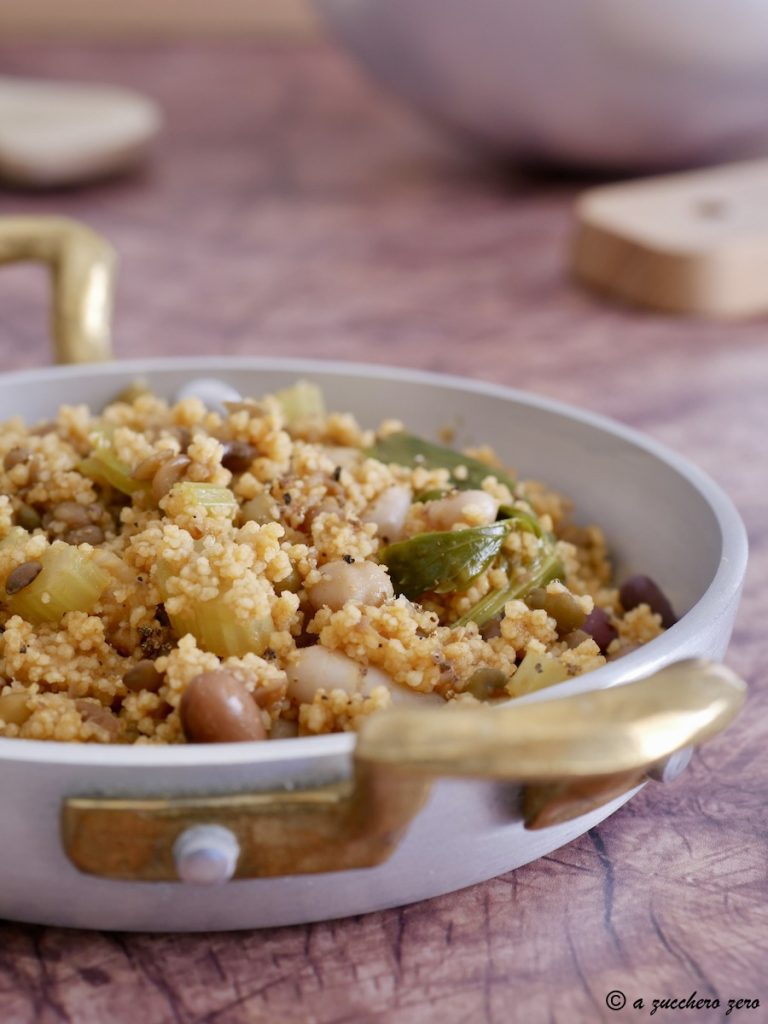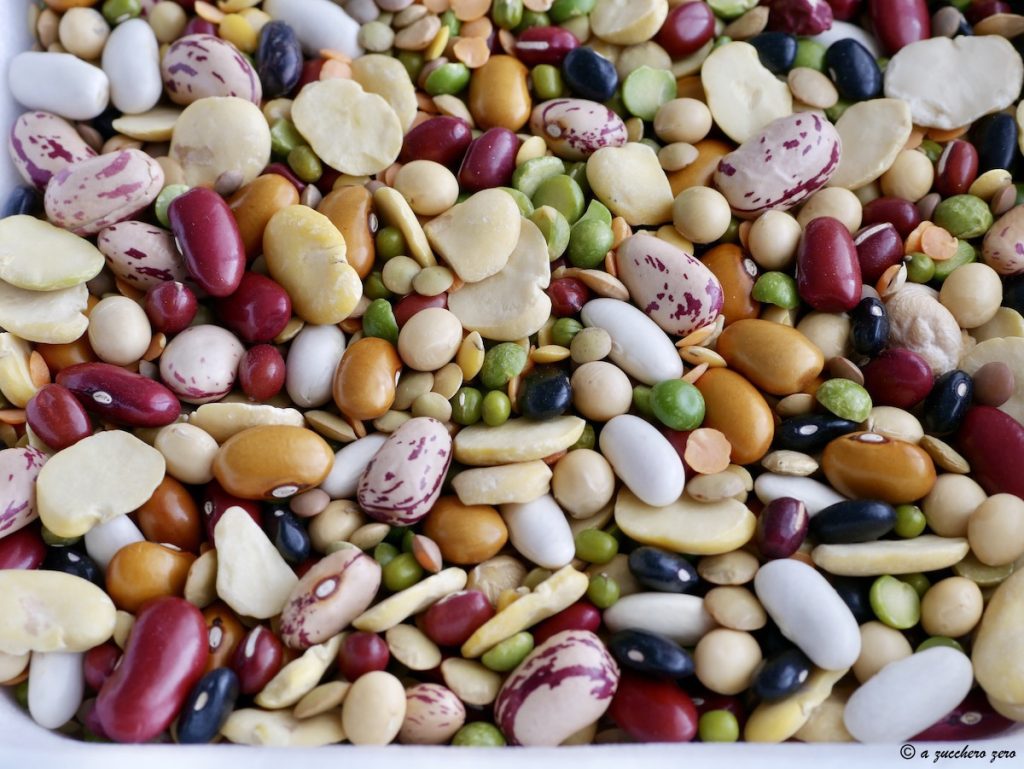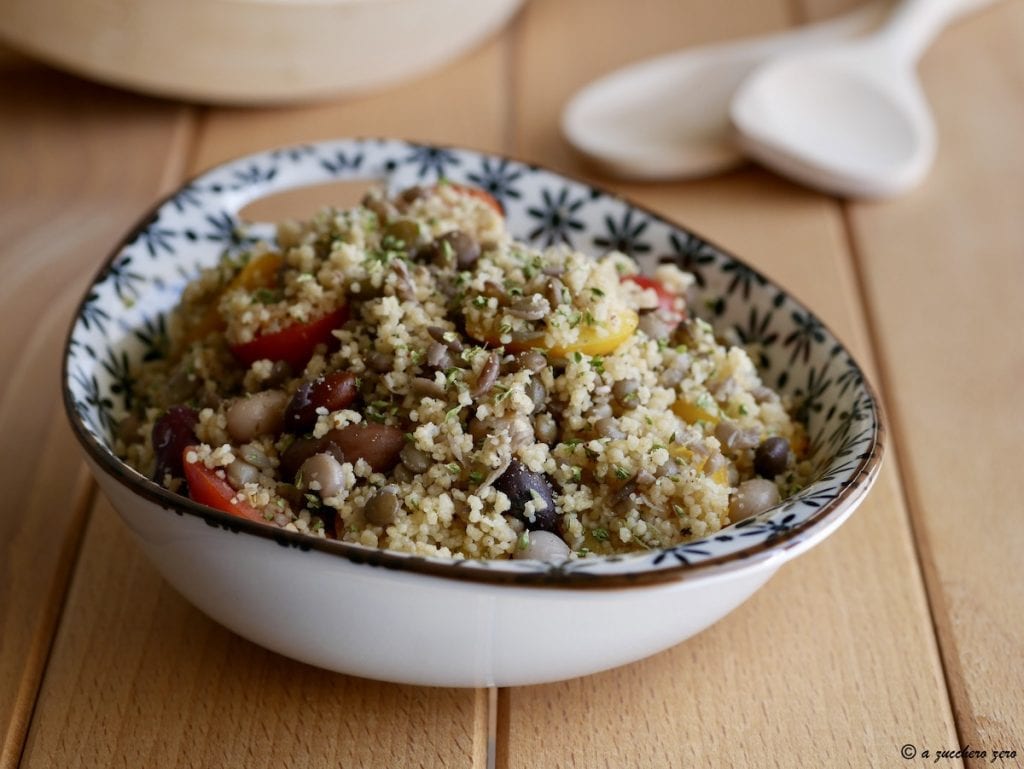The whole wheat couscous with legumes and vegetables is light and nutritious.
I prepared my couscous with mixed legumes.
The success of the recipe primarily depends on the quality of the couscous, choose a couscous:
• with clear and simple packaging instructions;
• whole wheat [easily found in organic stores].
The caloric intake of an 80 g serving of couscous is quite similar to that of a serving of pasta: about 300 kcal [source: greenstyle.com]; for quantities, refer to your dietary plan, considering that 50 g (1.76 oz) is already a generous portion.
Originating from North Africa and popular in the Mediterranean, couscous or couscous, or cuscus is made from coarsely ground durum wheat semolina, moistened with water, sieved, and hand-rolled into tiny grains.
According to tradition, it is steamed in a terracotta pot called a couscousière.
• As for the mixed legumes, I prepare several portions to have a small and practical stock in the freezer:
– cooking mixed legumes [basic recipe] digestible and light.
This way, you just need to thaw them in time, and in a few minutes, the pasta will be ready without using canned legumes.
Otherwise, remember that dried legumes need soaking [12-24 hours].
For preparation time, consider:
• 12-24 hours of soaking;
• 40 minutes for cooking the mixed legumes;
• 5 minutes for preparing the couscous.
If you use ready-mixed legumes, only calculate the couscous preparation time.
Regarding the vegetables, I flavored with homemade vegetable broth [carrot, onion, celery] and added onion and celery.
You can customize it according to taste by varying the legumes [only chickpeas, only beans, only fava beans, only lentils] and using previously boiled and/or leftover vegetables… fridge-cleaning and seasonal.

- Difficulty: Easy
- Cost: Economical
- Portions: 2 people
- Cuisine: Italian
Ingredients
- pre-cooked mixed legumes (for 2 people)
- 1 pinch garlic powder
- to taste onion (chopped)
- to taste celery (chopped)
- 1 vegetable broth cube (homemade)
- to taste tomato sauce (homemade)
- 7 fl. oz water
- 1 pinch salt
- 1 pinch mixed peppercorns (with grinder)
- 4.2 oz whole wheat couscous
- 4 fl. oz vegetable broth (taken from legumes and vegetables)
- 1 tbsp extra virgin olive oil (raw)
- 1 pinch mixed peppercorns (with grinder)
- 1 pinch mixed peppercorns (with grinder)
- 1 drizzle extra virgin olive oil (raw)
Preparation

Prepare the mixed legumes following the procedure described in cooking mixed legumes [basic recipe] digestible and light or, if you already have them ready in the freezer, thaw a double portion.
As for the vegetables, I flavored them with homemade vegetable broth [carrot, onion, celery] and added onion and celery [stalk and leaves].
You can customize it according to taste by using previously boiled and/or leftover vegetables… fridge-cleaning and seasonal.
In a hot pan, brown a sprinkle of garlic powder.
Add onion and celery and let them wilt for a few seconds.
Pour in the mixed legumes.
Add:
• a cube of vegetable broth;
• a few tablespoons of tomato sauce;
• 7 fl. oz of water;
• a pinch of salt;
• a pinch of pepper;
and bring to a boil.
Turn off the heat and take from the pan the broth needed to revive the couscous [same quantity as the couscous].
Prepare the whole wheat couscous following the instructions on the package:
• pour the couscous into a large salad bowl;
• add a teaspoon of extra virgin olive oil and mix with a fork;
• pour the hot broth over the couscous;
• cover and wait 5 minutes for it to swell.Fluff the couscous with a fork.
Grind the pepper and mix.
Bring the legumes back to a boil and, if necessary, continue cooking until the desired consistency.
Pour the couscous into the pan with the legumes or, if you prefer, the mixed legumes over the couscous and mix until they are evenly distributed among the grains.
Plate.
Grind a bit more pepper.
Add a drizzle of raw oil.
Your whole wheat couscous with legumes and vegetables is ready.
Enjoy your meal!
Combining with pasta, rice, or other cereals allows for optimal absorption of the proteins in legumes.
The cereals in these dishes compensate for the amino acids missing in legumes, resulting in a complete amino acid profile.
Choose cereals preferably whole wheat.
For more information: how to combine legumes in the diet.
Notes
Hyperglycemia, prediabetes and diabetes.
Here you can find dedicated recipes.
Remember:
• start the meal with a generous portion of vegetables [raw or cooked];
• a balanced meal must contain all nutrients: carbohydrates, proteins, fats & fibers;
• always prepare it respecting the proportions and combinations indicated in your diet plan.
***
DO NOT COPY AND PASTE MATERIAL FROM THE BLOG generally and especially ON SOCIAL PROFILES AND GROUPS [photos, ingredients, procedure – NOT EVEN IN THE FORM OF A SUMMARY]: it is correct to share your photos of the recipes you have made by indicating the source, i.e. linking the blog where the recipe can be read in full.
FOR COPYRIGHT REASONS AND ALSO FOR THE MUCH WORK BEHIND IT.
Thank you.


